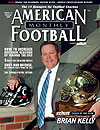Article CategoriesAFM Magazine
|
Specificity for Football Quicknessby: Dale BaskettFootball Speed Specialist © More from this issue Of the many important aspects of football is movement speed and quickness. Quickness is near the top, if not on top, of every coaches list. Sometimes as coaches we get caught up with the forty times and we can easily underachieve for quickness development. When quickness and acceleration are coupled together we have the formula for the most dynamic results one can expect. Quickness applies for one step, several feet or yards, depending on the assignment. Another type of quickness can be reflexive reaction before a step is even taken. My intent for this article is to cover movement quickness for football and how specificity can play a major role for quality results. While some of your players may possess natural quickness, my objective is to improve the overall team quickness.
|
|
|||||||
| HOME |
MAGAZINE |
SUBSCRIBE | ONLINE COLUMNISTS | COACHING VIDEOS |
Copyright 2025, AmericanFootballMonthly.com
All Rights Reserved





